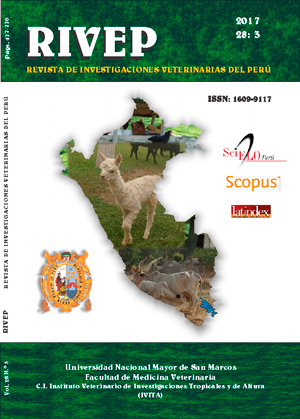Species of cyathostomin resistant to albendazole in equines, Cuba
DOI:
https://doi.org/10.15381/rivep.v28i3.13347Keywords:
albendazole, cyathostomes, efficacy, resistanceAbstract
This study aimed to evaluate the efficacy of anthelmintic used in an equine ranch in Cuba. The faecal egg count reduction test of Strongyles (FECRT) was used to evaluate albendazole and ivermectin. Thirty-three horses were selected (18 treated with albendazole, 15 treated with ivermectin). The egg count reduction for albendazole was 38% for micronized albendazole and 33% for albendazole sulfoxide. Ivermectin effectiveness was 100%. Subsequently, four horses that showed high counts of eggs after the albendazole treatment were treated with ivermectin on day 17 after the initial deworming to collect resistant nematodes in the faeces. These nematodes were morphologically identified. It was possible to identified 493 specimens: Cylicocyclus nassatus, Cyathostomum catinatum, Cylicostephanus longibursatus, Cylicostephanus goldi and Cylicostephanus minutus which represented 78.5, 7.7, 6.5, 3.9 and 3.4% respectively. This has been the first report for Cylicostephanus minutus in equines in Cuba. It is concluded that at least five of species of cyathostomes were resistant to albendazole.Downloads
Downloads
Published
Issue
Section
License
Copyright (c) 2017 Josmel Salas-Romero, Karel Gómez, Yanise Chicoy, José C. Yero, Edel Valle, Anay Delgado-Martínez, Jorge E. Salas-Romero, Amilcar Arenal

This work is licensed under a Creative Commons Attribution-NonCommercial-ShareAlike 4.0 International License.
AUTHORS RETAIN THEIR RIGHTS:
a. Authors retain their trade mark rights and patent, and also on any process or procedure described in the article.
b. Authors retain their right to share, copy, distribute, perform and publicly communicate their article (eg, to place their article in an institutional repository or publish it in a book), with an acknowledgment of its initial publication in the Revista de Investigaciones Veterinarias del Perú (RIVEP).
c. Authors retain theirs right to make a subsequent publication of their work, to use the article or any part thereof (eg a compilation of his papers, lecture notes, thesis, or a book), always indicating the source of publication (the originator of the work, journal, volume, number and date).










